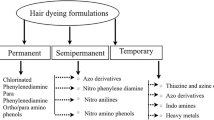Abstract
Objectives: The reported mutagenic and carcinogenic effects of some chemicals present in hair dyes have raised concern that hair dye use could increase breast cancer risk. This case–control study evaluated how detailed aspects of hair coloring and hair spray application by reproductive-age women may affect breast cancer risk.
Methods: Cases were white female residents of three counties of western Washington state 45 years of age or less, who were diagnosed with breast cancer between 1983 and 1990 (n = 844). A sample of similarly aged women residing in the same counties served as controls (n = 960). Information on hair coloring and hair spray use, as well as other exposures, was ascertained during in-person interviews.
Results: Breast cancer cases were slightly more likely than controls to report ever having used some type of hair coloring application, including use of rinses, semi-permanent or permanent dyes, as well as bleaching then dyeing or frosting their hair (relative risk [RR] = 1.3, 95% CI = 1.0–1.6, adjusted for age, fullterm pregnancies, family history of breast cancer, and weight). In subgroup analyses, women with exclusive use of just one of these methods of hair coloring application had no elevation in risk (similarly adjusted RR = 1.1, 95% CI = 0.9–1.3), whereas women who used two or more of these methods did have an elevated risk (RR = 1.9, 95% CI = 1.4–2.5). Hair spray use was not related to the risk of breast cancer (ever versus never users: RR = 1.0, 95% CI = 0.8–1.3).
Conclusion: The lack of an association between exclusive use of a single type of hair coloring application and breast cancer risk argues that hair coloring application does not influence breast cancer risk among reproductive-age women. Thus, the results of the present study, as well as negative ones from most (but not all) prior studies, are most consistent with the conclusion that neither hair coloring application nor hair spray application influences breast cancer risk.
Similar content being viewed by others
References
Ames BN, Kammen HO, Yamasaki E (1975) Hair dyes are mutagenic: identification of a variety of mutagenic ingredients. Proc Natl Acad Sci 72: 2423-2427.
Flamm WG (1985) Hair Dyes: Laboratory Evidence. IARC Scientific Publications No. 65, Lyon: International Agency for Research on Cancer.
Shafer N, Shafer RW (1976) Potential of carcinogenic effects of hair dyes. NY State J Med 76: 394-396.
Kinlen LJ, Harris R, Garrod A, Rodriguez K (1977) Use of hair dyes by patients with breast cancer: a case-control study. Br Med J 2: 366-368.
Hennekens CH, Rosner B, Belanger C, Speizer FE, Bain CJ, Peto R (1979) Use of permanent hair dyes and cancer among registered nurses. Lancet 1: 1390-1393.
Stavraky KM, Clarke EA, Donner A (1979) Case-control study of hair dye use by patients with breast cancer and endometrial cancer. J Natl Cancer Inst 63: 941-945.
Shore RE, Pasternack BS, Thiessen EU, Sadow M, Forbes R, Albert RE (1979) A case-control study of hair dye use and breast cancer. J Natl Cancer Inst 62: 277-283.
Nasca PC, Lawrence CE, Greenwald P, Chorost S, Arbuckle JT, Paulson A (1980) Relationship of hair dye use, benign breast disease, and breast cancer. J Natl Cancer Inst 64: 23-28.
Stravraky KM, Clarke EA, Donner A (1981) A case-control study of hair-dye use and cancers of various sites. Br J Cancer 43: 236-239.
Wynder El, Goodman M (1983) Epidemiology of breast cancer and hair dyes. J Natl Cancer Inst 71: 481-488.
Green A, Willet WC, Colditz GA, et al. (1987) Use of permanent hair dyes and risk of breast cancer. J Natl Cancer Inst 79: 253-257.
Koenig KL, Pasternack BS, Shore RE, Strax P (1991) Hair dye use and breast cancer: a case-control study among screening participants. Am J Epidemiol 133: 985-995.
Nasca PC, Baptiste MS, Field NA, Metzger BB, DeMartino R (1992) An epidemiologic case-control study of breast cancer and exposure to hair dyes. Ann Epidemiol 2: 577-586.
Thun MJ, Altekruse SF, Namboodiri MM, Calle EE, Myers DG, Heath CW Jr (1994) Hair dye use and risk of fatal cancers in US women. J Natl Cancer Inst 86: 210-215.
Hunter DJ, Willet WC (1993) Diet and body build. Epidemiol Rev 15: 110-132.
Daling JR, Malone KE, Voigt LF, White E, Weiss NS (1994) Risk of breast cancer among young women: relationship to induced abortion. J Natl Cancer Inst 86: 1584-1592.
Waksberg J (1978) Sampling methods for random digit dialing. J Am Stat Soc 73: 40-46.
Breslow NE, Day NE (1980) Statistical Methods in Cancer Research, Vol. 1: The Analysis of Case—Control Studies. Lyon: International Agency for Research on Cancer.
Kiese M, Rauscher E (1968) The absorption of p-toluenediamine through human skin in hair dyeing. Toxicol Appl Pharmacol 13: 325-331.
Kinkel HJ, Holzmann S (1973) Study of long-term percutaneous toxicity and carcinogenicity of hair dyes (oxidizing dyes) in rats. Food Cosmet Toxicol 11: 641-648.
Jacobs MM, Burnett CM, Penicnak AJ, et al. (1984) Evaluation of the toxicity and carcinogenicity of hair dyes in Swiss mice. Drug Chem Toxicol 7: 573-586.
Weisburger EK, Russfield AB, Homburger F, et al. (1978) Testing of twenty-one environmental aromatic amines or derivatives for long-term toxicity or carcinogenicity. J Environ Pathol Toxicol 2: 325-356.
Burnett C, Lanman B, Giovacchini R, Wolcott G, Scala R, Keplinger M (1975) Long-term toxicity studies on oxidation hair dyes. Food Cosmet Toxicol 13: 353-357.
Searle CE, Jones EL (1977) Effects of repeated applications of two semi-permanent hair dyes to the skin of A and DBAf mice. Br J Cancer 36: 467-477.
Milady's Standard Textbook of Cosmetology (1995) Albany, NY: Milady Publishing Co. (a Division of Delmar Publishers).
Author information
Authors and Affiliations
Rights and permissions
About this article
Cite this article
Cook, L.S., Malone, K.E., Daling, J.R. et al. Hair product use and the risk of breast cancer in young women. Cancer Causes Control 10, 551–559 (1999). https://doi.org/10.1023/A:1008903126798
Issue Date:
DOI: https://doi.org/10.1023/A:1008903126798




